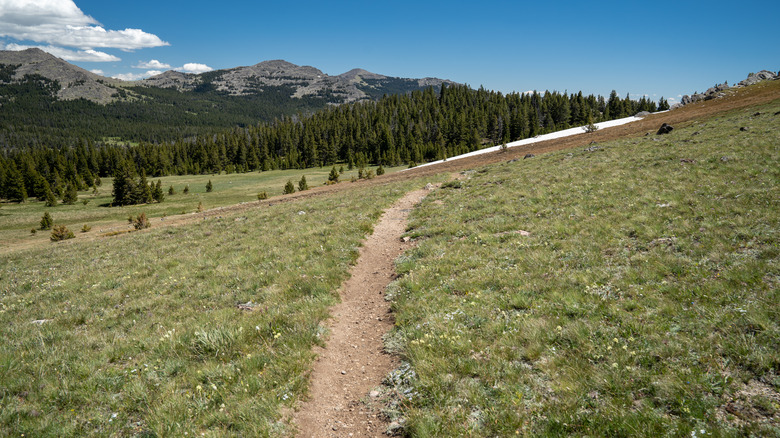One Of America's Most Picturesque Mountain Ranges For Outdoor Adventure Crosses State Borders
We may receive a commission on purchases made from links.
Named for the iconic rams that call their peaks home, the Bighorn Mountains are a true western gem. Extending for 150 miles from northern Wyoming into southern Montana, this sister range of the Rockies is often overlooked in favor of its more famous sibling. Still, the Bighorns offer scads of rugged splendor and adventure for outdoors enthusiasts and are well worth visiting for anyone keen to dive into the natural treasures of the western U.S.
Situated within the national forest bearing their name, the Bighorns are formidable mountains in their own right, with two peaks — Cloud Peak and Black Tooth Mountain — reaching heights of over 13,000 feet. The range is also teeming with wildlife, including deer, elk, moose, black bears, mountain lions, and both bald and golden eagles.
While most anywhere in the Bighorns is worth checking out, the Cloud Peak Wilderness is the range's most pristine and arguably prettiest area. This zone of protected, roadless, high-mountain terrain is as wild as it gets, and hikers flock here by the thousands to experience solitude in untouched surroundings. That said, you can also enjoy the glory of the Bighorns from the comfort of your vehicle, as U.S. Highway 14 — which crosses the range — has been designated as an official scenic byway.
A wall of rock rising from the prairie
One of the best things about the Bighorns is their location. The mountains sit just about halfway between Yellowstone and Mt. Rushmore, making them a perfect stopping-off point on a great western road trip. The range makes its presence known from afar, rising starkly from the Wyoming flatlands. And even though they look extremely rugged, the Bighorns are more rounded than other ranges in the region, which is one of the reasons hikers can't resist their pull.
Of course, there is much more to do in the Bighorns than trek along trails. It's ideal terrain for mountain biking, and there are loads of places to camp. The area is also perfect for fly-fishing, with anglers regularly wetting their lines in the multitude of rivers and streams, as well as spots like Upper and Lower Medicine Lodge Lake. In the winter, the mountains are blanketed in deep snow, making it great for skiing, snowshoeing, snowboarding, and other cold weather sports. Sometimes referred to as "Little Jackson Hole," the Meadowlark Ski Area and Lodge has 320 acres of deep-powder bliss, with 35 trails ranging from beginner to advanced.
While you're exploring the Bighorns, be sure to stop off at Shell Falls, a 120-foot waterfall blasting down and then flowing into the Bighorn River. Also check out Copman's Tomb, an impressive, 4000-foot rock formation near the falls, and Medicine Wheel is not to be missed. This stone structure sits atop a 9,642-foot peak and is a sacred site for the native Crow, Cheyenne, and Sioux people.
Immerse yourself in alpine sublimity
The Cloud Peak Wilderness is a 191,941 acre reserve that stretches for 27 miles over the stony back of the Bighorn Mountains. The wilderness is home to hundreds of lakes that drain into rivers and streams, as well as stands of spruce and pine broken up by grasslands and meadows, making for some stunning open country.
Named for Cloud Peak — which, at 13,167 feet, is the Bighorn's highest — the wilderness boasts over 100 miles of hiking trails. This makes backpacking among the rocky rises and peaks the area's chief draw, and while the length and difficulty of the hikes varies, the terrain can be rough and demanding. That said, with proper preparation, a long walk in the Cloud Peak Wilderness promises to be as rewarding as it is demanding.
Popular routes include the Sherd Lake Loop, which takes you past several alpine lakes on its 10.4 miles; the Solitude Loop, a 59.1-mile multi-day affair that rings Cloud Peak; and the ascent of Cloud Peak itself, a tough 23.4-mile roundtrip climb with an elevation gain of 5,516 feet. All of these routes are best for intermediate or advanced hikers in an area where the weather can change quickly, so be sure to pack wisely. Also, black bears are very active in the Cloud Peak Wilderness, so a bear canister is a must.


